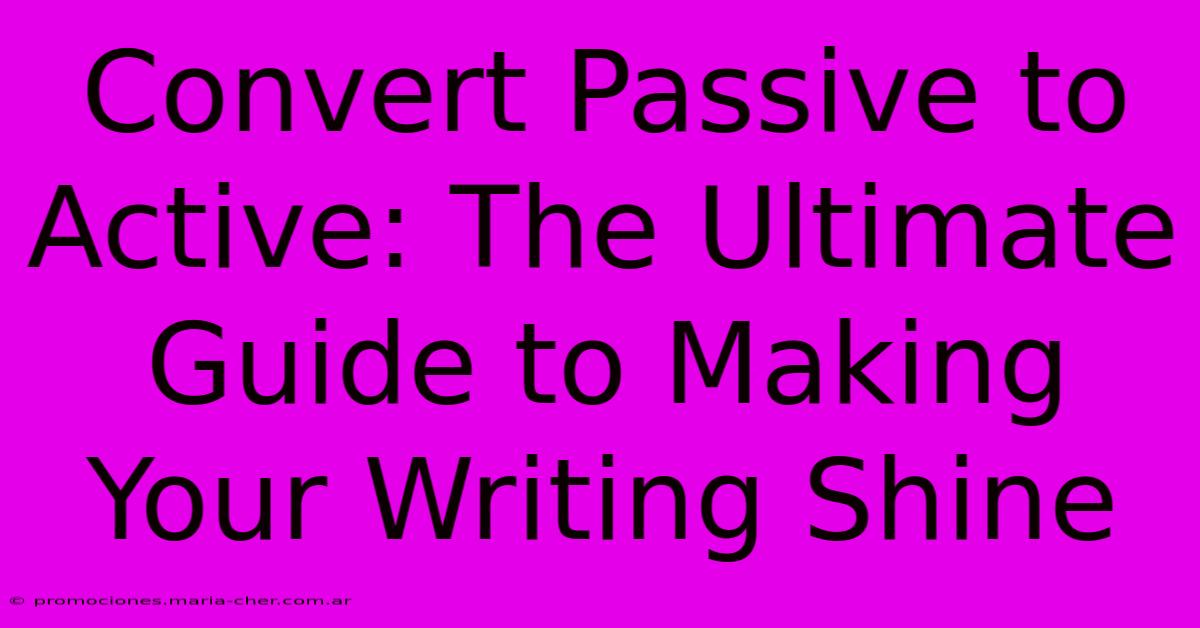Convert Passive To Active: The Ultimate Guide To Making Your Writing Shine

Table of Contents
Convert Passive to Active: The Ultimate Guide to Making Your Writing Shine
Are you tired of your writing feeling weak and indirect? Does your prose sound hesitant and unclear? The culprit might be passive voice. This comprehensive guide will show you how to convert passive to active voice, breathing life and energy into your writing and making it truly shine.
Understanding the Difference: Passive vs. Active Voice
Before we dive into the conversion process, let's clarify the core difference between passive and active voice. In active voice, the subject performs the action. The sentence structure follows a clear Subject-Verb-Object (SVO) pattern.
Example (Active): The dog chased the ball.
Here, "dog" (subject) performs the action "chased" (verb) on "ball" (object).
In passive voice, the subject receives the action. The sentence structure is often more convoluted, often involving a form of "to be" verb and a past participle.
Example (Passive): The ball was chased by the dog.
Notice how the focus shifts from the dog (the actor) to the ball (the receiver of the action). Passive voice often obscures the actor entirely.
Why Active Voice is Superior: Clarity and Impact
Active voice offers several key advantages:
- Clarity: Active voice makes your writing more direct and easier to understand. The reader immediately grasps who is doing what.
- Conciseness: Active sentences are generally shorter and more to the point, eliminating unnecessary words and improving flow.
- Strength and Energy: Active voice imbues your writing with a sense of dynamism and authority. It makes your writing more engaging and memorable.
- Professionalism: In many professional contexts (academic writing, business reports, etc.), active voice is preferred for its clarity and directness.
Identifying Passive Voice: Key Indicators
Identifying passive sentences is the first step to converting them. Look for these common indicators:
- Forms of "to be" verbs (is, am, are, was, were, been, being): These often precede the past participle in passive constructions.
- Past participles (e.g., chased, written, eaten): These are verb forms often used in passive sentences.
- Prepositional phrases beginning with "by": These frequently indicate the actor in a passive sentence (e.g., "by the dog," "by the committee").
Converting Passive to Active: A Step-by-Step Guide
Here's a practical method for converting passive sentences to their active counterparts:
- Identify the subject: Find the noun or pronoun that's receiving the action.
- Identify the actor: Determine who or what is performing the action. This might be implied or hidden in a prepositional phrase.
- Identify the verb: Find the main verb in the passive sentence.
- Rewrite the sentence: Place the actor as the subject, use the active form of the verb, and place the object (if there is one) after the verb.
Example:
- Passive: The report was written by John.
- Active: John wrote the report.
More Complex Examples:
-
Passive: Mistakes were made by the team during the project.
-
Active: The team made mistakes during the project.
-
Passive: The decision was influenced by several factors.
-
Active: Several factors influenced the decision.
Exceptions to the Rule: When Passive Voice is Acceptable
While active voice is generally preferred, there are certain situations where passive voice can be appropriate:
- When the actor is unknown or unimportant: The window was broken. (The actor is unknown)
- When you want to emphasize the action, not the actor: The prize was awarded to Sarah. (Focus is on the award)
- To maintain objectivity in scientific writing: The experiment was conducted under controlled conditions.
Practice Makes Perfect: Sharpening Your Skills
The key to mastering active voice is practice. Review your own writing, paying close attention to sentence structure. When you identify passive sentences, actively rewrite them in the active voice. Read widely and analyze how accomplished writers utilize active voice to create clear, concise, and engaging prose. With consistent practice, you'll significantly improve your writing and make it shine!
Conclusion: Embrace the Power of Active Voice
By understanding the distinctions between active and passive voice and diligently practicing conversion techniques, you can dramatically enhance your writing style. Active voice brings clarity, strength, and dynamism to your prose, making it more impactful and engaging for your readers. So, embrace the power of active voice and watch your writing flourish!

Thank you for visiting our website wich cover about Convert Passive To Active: The Ultimate Guide To Making Your Writing Shine. We hope the information provided has been useful to you. Feel free to contact us if you have any questions or need further assistance. See you next time and dont miss to bookmark.
Featured Posts
-
Money Magic How To Save A Fortune On Carpal Tunnel Surgery
Feb 09, 2025
-
Fillets Redefined A Gourmets Guide To Exceptional Seafood
Feb 09, 2025
-
The Dark Side Of Veggies Exploring The Enigmatic Charred Vegetable Universe
Feb 09, 2025
-
Immerse Yourself In The Coolest Sci Fi Odyssey 5 Movies That Will Transport You To Another Dimension
Feb 09, 2025
-
Saber Vs Sabre The Search For Semantic Enlightenment
Feb 09, 2025
